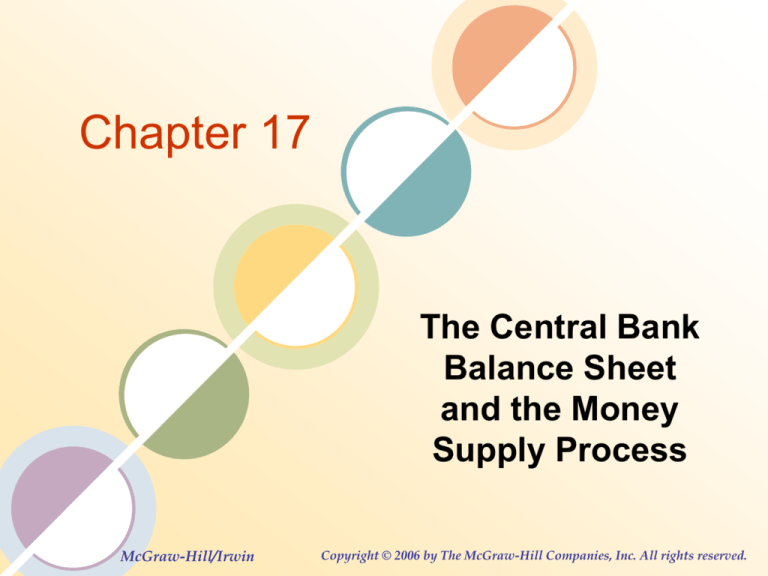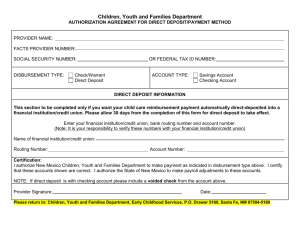
Chapter 17
The Central Bank
Balance Sheet
and the Money
Supply Process
McGraw-Hill/Irwin
Copyright © 2006 by The McGraw-Hill Companies, Inc. All rights reserved.
The Central Bank’s Balance Sheet
Web Link
17-2
The Central Bank’s Balance Sheet
Assets
• Securities
• Fed holds only U.S. Treasury securities
• controlled through purchases and sales known as
“open market operations.”
• Foreign Exchange Reserves
• bonds issued by foreign governments
• Loans
• Discount Loans
• Float
17-3
The Central Bank’s Balance Sheet
Liabilities
• Currency
• Government Accounts
• Reserves
• Commercial Bank’s Checking Accounts
17-4
The Monetary Base
Monetary Base (or High-Powered Money)
• Currency held by the public + reserves in
the banking system
• Bank Reserves = Vault Cash + Deposits at
the Fed.
• The central bank can control the size of
the monetary base.
17-5
Changing Size and Composition of
the Balance Sheet
Open Market Operations
• The Federal Reserve buys or sells securities in
financial markets.
17-6
Changing Size and Composition of
the Balance Sheet
Open Market Operations
17-7
Changing Size and Composition of
the Balance Sheet
Foreign Exchange Intervention
17-8
Changing Size and Composition of
the Balance Sheet
Foreign Exchange Intervention
17-9
Changing Size and Composition of
the Balance Sheet
Discount Loans
17-10
Changing Size and Composition of
the Balance Sheet
Discount Loans
• Discount Loans
17-11
Changing Size and Composition of
the Balance Sheet
Cash Withdraws
• Cash Withdraws
17-12
Changing Size and Composition of
the Balance Sheet
Cash Withdraws
17-13
Changing Size and Composition of
the Balance Sheet
Cash Withdraws
17-14
Deposit Expansion Multiplier
Deposit Creation in a Single Bank
17-15
Deposit Expansion Multiplier
Deposit Creation in a Single Bank
Types of Reserves
• Actual Reserves (R)
• Required Reserves (RR=rDD)
• Excess Reserves (ER)
17-16
Deposit Expansion Multiplier
Deposit Creation in a Single Bank
17-17
Deposit Expansion Multiplier
Deposit Creation in a Single Bank
17-18
Deposit Expansion Multiplier
Deposit creation in a single bank
• As a result of a $100,000 purchases of
securities from bank by the Fed
• M1 increases $100,000.
• Checkable deposits increase $100,000.
17-19
Deposit Expansion Multiplier
Deposit creation by a system of banks
• Assume
• Bank hold no excess reserves.
• The reserve requirement ratio is 10%
• Currency holding doe not change when deposits and loans
change.
• When a borrower writes a check, none of the recipients of
the funds deposit them back in the bank that initially made
the loan.
17-20
Deposit Expansion Multiplier
Deposit creation by a system of banks
17-21
Deposit Expansion Multiplier
Deposit creation by a system of banks
17-22
Deposit Expansion Multiplier
Deposit creation by a system of banks
17-23
Deposit Expansion Multiplier
Figure 17.17: Multiple Deposit Creation
$100,000
Reserves
Federal
Federal
Reserve
Reserve
First Bank
$100,000
Loan
Office Builders
Inc.
$100,000
Securities
Third Bank
$90,000
Loan
Retains $9,000 in
Retains
$9,000 in
Reserves
Reserves
$81,000
Loan
Fourth Bank
Retains $8,100 in
Reserves
$100,000
Payment
Second Bank
$100,000
Deposit
Retains
Retains
$10,000
$10,000
in in
Reserves
Reserves
$72,900
Loan
Fifth Bank
American Steel
Co.
$65,610
Loan
and on
and on.
Retains $7,290 in
Reserves
Assuming a 10 percent reserve requirement, banks hold
no excess reserves, and there are no changes its currency holdings.
17-24
Deposit Expansion Multiplier
17-25
Deposit Expansion Multiplier
Deposit creation by a system of banks
• RR = rDD or ΔRR = rDΔD
• So for every dollar1 increase in reserves,
deposits increaserDby
17-26
Deposit Expansion Multiplier
Deposit creation by a system of banks
• RD=10% (0.10), and ΔRR=$100,000
1
• ΔD= $100,000
.1
• ΔD= $1,000,000
17-27
Deposit Expansion Multiplier
Deposit Expansion with Excess Reserves and Cash Withdraws.
Assume:
• 5% withdraw of cash.
• Excess reserves of 5% of deposits
17-28
Deposit Expansion Multiplier
Deposit Expansion with Excess Reserves and Cash Withdraws.
17-29
Deposit Expansion Multiplier
Deposit Expansion with Excess Reserves and Cash
Withdraws.
• The desire of banks to hold excess reserves and the
desire of account holders to withdraw cash both reduce
the impact of a given change in reserves on the total
deposits in the system. The more excess reserves
banks desire to hold, and the more cash that is
withdrawn, the smaller the impact.
17-30
Deposit Expansion Multiplier
Deposit Expansion with Excess Reserves and Cash Withdraws.
Ratios
• Excess Reserve Ratio {ER/D}
• Currency Ratio {C/D}
17-31
Deposit Expansion Multiplier
Deposit Expansion with Excess Reserves and Cash Withdraws.
1
D
MB
{C/D} rD {ER/D}
{C / D} 1
M
MB
{C/D} rD {ER/D}
17-32
Deposit Expansion Multiplier
The Quantity of Money (M) Depends on:
• The Monetary base (MB), Controlled by the Fed.
• Reserve Requirements
• Bank’s desired to hold excess reserves.
• The public’s demand for currency.
17-33
Deposit Expansion Multiplier
17-34
Deposit Expansion Multiplier
17-35
Deposit Expansion Multiplier
17-36
Chapter 17
End of Chapter
McGraw-Hill/Irwin
Copyright © 2006 by The McGraw-Hill Companies, Inc. All rights reserved.








